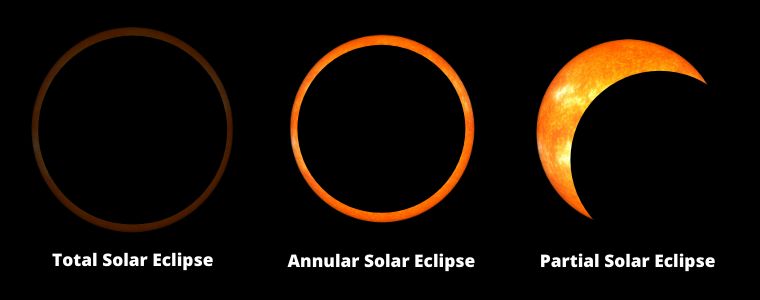When the moon passes in front of the sun, it casts a shadow across the earth and causes an eclipse. The solar eclipse is also known as occultation.
Fact About Solar Eclipse
- There are between 2 and 5 solar eclipses every year.
- 7.5 minutes is the longest duration for a total solar eclipse.
- The width of the path of totality is at most 167 miles wide.
- Total solar eclipses happen about once every 17 months.
- Almost identical eclipses occur after 18 years and 11 days.
- You’ll have a chance to see the rare, partial solar eclipse if you’re up to 3,000 miles from where totality is.
- The Moon moves approximately 2,250 km (1,398 miles) per hour as it crosses the Sun.
- From either the North or the South Pole, only a partial solar eclipse is able to be viewed.
- Jupiter, Venus, and Mercury can all be seen during a total solar eclipse.
- The shadow bands are a beautiful event to witness as they occur before totality.
What is a Solar Eclipse?
The sunlight can be completely blocked, or it may only partially disappear depending on the geometry of the Sun, Moon, and Earth. This natural event takes place when our moon moves in its orbit between earth and the sun (also known as an occultation).
It happens at New Moon which is considered to be when a solar eclipse occurs because this time usually coincides with conjunction. Where both the sun and new moon are lined up together.
If there was just one slight difference without any variations from what we would call normal circumstances then that’s all you need for eclipses each month; but alas! The lunar orbital plane isn’t circular like ours so monthly events rarely happen here on planet Earth unless they’re scheduled by astrologists ahead of time.
Did you know that during an eclipse, the Moon’s shadow moves across Earth’s surface? It is divided into two parts: a dark umbra and a lighter penumbra.
Safety note – do NOT ever look at the Sun directly while it is covered by either type of moon/shadow since its bright light can damage your eyes very quickly!
Solar Eclipse Types

Total Solar Eclipse
A total solar eclipse occurs when the Moon completely blocks the Sun’s outermost layer or photosphere. This causes a shadow to form in what is called “the zone of totality.”
The total solar eclipse is the only time when it’s safe to look directly at the sun (with special solar filters to protect your eyes). Observers can also see a phenomenon called “Bailey’s Beads” as sunlight shines out through valleys on the surface of our moon during totality. If there are active prominences, loops, and flares from an unprominent Sun, observers may be able to view them too!
The moon has been moving away from Earth at a rate of about 2 centimeters per year. In the current epoch, there are periods when it lines up in such a way that you can’t see any part of the Sun behind it. However, as time goes on and this alignment becomes less perfect with respect to our position here on Earth (and more so for observers farther out), we’ll only be able to experience partial eclipses and annular ones until they disappear completely!
Annular Solar Eclipse
The annular solar eclipse is one of the most beautiful to watch, with a bright ring surrounding the dark disk of our moon. The Latin word “annulus” means “ring” and this type of eclipse produces an effect so beautifully breathtaking as you witness its glowing light surround only part of the sun in all its brilliance while still casting darkness on everything around it.
These events require eye protection throughout the entire eclipse. Annular solar eclipses can last up to 12 minutes long, but even though there is a lot of darkness during annularity, enough light escapes that you must protect your eyes from this event while it lasts!
Partial Solar Eclipse
A partial solar eclipse occurs when Earth moves through the lunar penumbra as the Moon blocks out a small part of our Sun. Partial eclipses are best seen from areas like South America, Africa, and Asia where they will only see up to 50% coverage on their sun’s light. Depending on your location during a partial eclipse you might not even notice any changes at all!
A total solar eclipse is an event that happens every 18 months or so because of how we orbit around each other in space – with one partner (Earth) always chasing after another (the moon).
As a precautionary measure, avoid looking directly at the eclipse. If you want to see it safely, use approved filters or indirect methods of viewing such as projecting sunlight through a telescope and onto white paper/cardboard never look at an astronomical object with your eye without proper protection!
When is the next Solar Eclipse?
For those of you who like to be prepared, it’s time for an eclipse! Solar eclipses occur every year and are predictable. You can find calendars with all the solar eclipse types online at several different sites.
Eclipses in 2021
| Eclipses Date | Type | Best Viewing Location |
|---|---|---|
| 23 May | Lunar Eclipse (Total) | South/East Asia, Australia, Musch of North America, South America, Pacific, Atlantic, Indian Ocean, Antarctica |
| 10 Jun | Solar Eclipse (Annular) | Musch of Europe, Musch of Asia, North/West Africa, Musch of North America, Atlantic, Arctic |
| 18-19 Nov | Lunar Eclipse (Partial) | Much of Europe, Much of Asia, Australia, North/West Africa, North America, South America, Pacific, Atlantic, Indian Ocean, Antarctica |
| 4 Dec | Solar Eclipse (Total) | South in Australia, South in Africa, South in America, Pacific, Atlantic, Indian Ocen, Antarctica |



